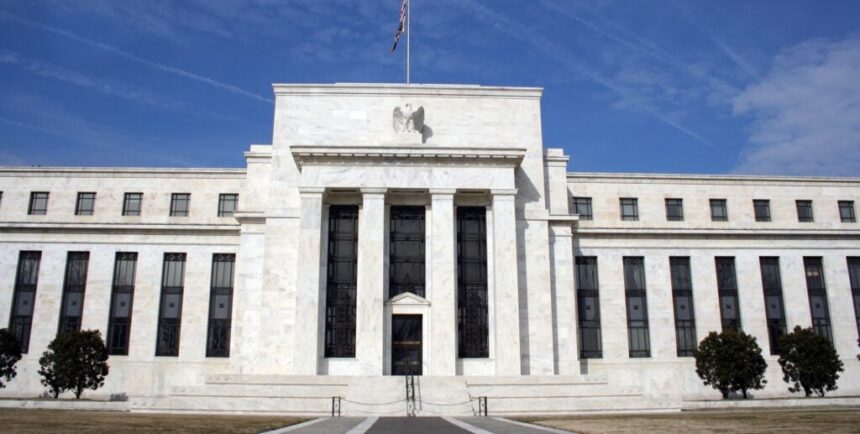Over the last couple of years, many economists and investors have criticized the Federal Reserve for failing to tackle inflation earlier.
In March 2020, the federal funds rate was slashed to nearly 0% in response to COVID-19. By March 2021, inflation reached 2.6%. Two months later, it hit 5%. By March 2022, inflation reached 8.5%. Only then, when inflation was already reaching multi-decade highs, the Fed decided to act, opting to increase the federal funds rate by 75 basis points.
It was too late, though, and inflation continued to increase, reaching an apex of 9.1% by June 2022. In total, the Federal Reserve has increased the federal funds rate 11 times over the last year and a half, resulting in a 5.25-5.5% benchmark rate, the highest in 22 years.
The narrative is widely known, yet the underlying dynamics of inflation and the timing of the Fed’s response remain perplexing. Ed Coulson, Director of the Center for Real Estate at the University of California-Irvine, suggested in a recent interview with the Los Angeles Daily News that our grasp of these events is hampered by fundamental issues with how we measure inflation.
Has the Fed Been Misreading Inflation All Along?
According to Coulson, the crux of the issue is that consumer price index (CPI) data shouldn’t be used as a macroeconomic policy advisor due to its sluggish nature.
Inflation, as measured by the CPI, starts with a market basket of goods and services, representing typical purchases by consumers, as determined by the Consumer Expenditure Surveys conducted by the Bureau of Labor Statistics (BLS). Each month, the BLS gathers prices for approximately 80,000 items from various sources, including retail stores, service establishments, online sales, and, perhaps most critically, rental units. These items are weighted according to their importance in average household spending, and adjustments are made to account for quality changes in goods and services.
Rental prices, in particular, tend to carry the largest weight as housing is normally a person’s largest expense. The weighing of rent can contribute anywhere from 30-45% of the index’s total, making it all the more important to get an accurate number.
The problem, however, is that when the BLS goes through its surveys, it only asks for a consumer’s rent price today compared to six months ago. And that, Coulson explains, is why the Fed didn’t act in those early days of the pandemic and why it continues to raise rates.
“That’s not contemporaneous information because the rent you’re paying right now depends on a lease that you signed six, eight, 10 months ago.
So, it is very sluggish and lags the true state of the housing market by six months at least.
If (the Fed) had measured inflation properly, they probably would have raised rates very much sooner than they did. And they should stop raising rates now because rents now have leveled off. In fact, our measure of current rental inflation is zero when the Fed still is measuring it at 3% to 4%.”
Coulson advocates for a better method of tracking rental inflation: using new leases signed on vacant units.
“That’s what you want. We have a more recent technique, which simply takes Real Capital Analytics data on the multifamily market, and we can convert that into an apartment rent inflation index.
And if you input that into the CPI and take out the Fed’s rental measure, it shows a drop in the rental inflation rate.”
It’s true that rental prices have been on the downswing in recent months. Since August, rent prices have recorded a month-over-month decrease, following a similar pattern in the same time frame last year.


Based on these charts, it’s pretty obvious that rental price growth was way out of line by late spring 2021. It’s also evident that rental inflation is now in deflation mode. So, how long will it take the Fed to act before it reduces interest rates?
Will It Take as Long To Reduce as It Did To Increase?
At the moment, most economists believe that the federal funds rate has peaked and rates will begin to fall anywhere from April to June next year.
In general, the Fed is looking for one of two things to occur in order to begin cutting rates—first, a recession. If a recession occurs, the most obvious action they’ll take is to cut rates to prop up the economy. We reported earlier this month on Wells Fargo’s assessment of a potential recession, and the odds remain high that we could tip into one. The scale of a recession is up in the air, but I’d expect rates to get cut regardless.
The second scenario is a lower inflation rate, down to 2% instead of the 3-4% it sits at now, and an economy that continues to chug along. This would be the “soft landing” the Fed was looking for and could become a reality as soon as early 2024.
Meanwhile, housing prices remain near record highs, and sales activity stays dormant. If the Fed were to lower rates, then it’s very likely that housing could appreciate even more as demand would flood the market. Obviously, this is the double-edged sword facing the housing market, but investors are fans of cheaper debt in any case.
But the Fed is more concerned about job growth and the cost of living than it is with the actual cost of a home. If anything, lowering rates could inspire more builders to enter the market with cheaper debt and cheaper materials. However, we wouldn’t feel the impact of new units for another year or two, so expect prices to remain elevated for the foreseeable future.
As for rates, we might see motion as soon as Q1 and as late as Q3-Q4 2024.
Ready to succeed in real estate investing? Create a free BiggerPockets account to learn about investment strategies; ask questions and get answers from our community of +2 million members; connect with investor-friendly agents; and so much more.
Note By BiggerPockets: These are opinions written by the author and do not necessarily represent the opinions of BiggerPockets.









